Blue Plastic Ring With 2 Wires With Loops at the End Fishing Gear


A completed assembly of tackle ready for fishing is sometimes called a rig, such as this Carolina rig.
Angling tackle is the equipment used by anglers when fishing. Virtually whatever equipment or gear used for angling tin be chosen fishing tackle. Some examples are hooks, lines, sinkers, floats, rods, reels, baits, lures, spears, nets, gaffs, traps, waders and tackle boxes.
Gear that is attached to the end of a line-fishing line is called terminal tackle. This includes hooks, leaders, swivels, sinkers, floats, split rings and wire, snaps, chaplet, spoons, blades, spinners and clevises to attach spinner blades to fishing lures, and tools that arrive easy to tie knots. Sometimes the term fishing rig is used for a completed assembly of tackle ready for fishing.
Angling tackle can exist contrasted with fishing techniques. Fishing tackle refers to the concrete equipment that is used when fishing, whereas angling techniques refers to the manner in which the tackle is used when fishing.
The term tackle, with the pregnant "apparatus for fishing", has been in use from 1398 AD.[1] Fishing tackle is also chosen line-fishing gear. However the term fishing gear is more than usually used in the context of commercial fishing, whereas fishing tackle is more than often used in the context of recreational fishing. This article covers equipment used by recreational anglers.
Claw, line and sinker [edit]
Hook, line and sinker is a classic combination of tackle empowering an angler to grab fish.
Hooks [edit]
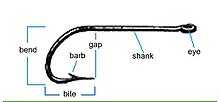
The utilize of the hook in angling is descended, historically, from what would today exist called a "gorge". The word "gorge", in this context, comes from an primitive discussion meaning "throat". Gorges were used by ancient peoples to capture fish. A gorge was a long, thin piece of bone or stone fastened by its midpoint to a thin line. The gorge would be fixed with a bait then that it would rest parallel to the lay of the line. When a fish swallowed the bait, a tug on the line caused the gorge to orient itself at right angles to the line, thereby sticking in the fish's gullet.
A fish hook is a device for communicable fish either past impaling them in the oral cavity or, more rarely, by snagging the trunk of the fish. Fish hooks have been employed for millennia by anglers to catch fresh and saltwater fish. Early hooks were fabricated from the upper bills of eagles and from basic, shells, horns and thorns of plants (Parker 2002). In 2005, the fish hook was called by Forbes as one of the meridian twenty tools in the history of human being.[2] Fish hooks are usually attached to some grade of line or lure device which connects the caught fish to the angler. There is an enormous multifariousness of fish hooks. Sizes, designs, shapes, and materials are all variable depending on the intended purpose of the hook. They are manufactured for a range of purposes from full general line-fishing to extremely limited and specialized applications. Fish hooks are designed to concur various types of artificial, processed, dead or alive baits (bait fishing); to human activity as the foundation for bogus representations of fish prey (fly line-fishing); or to be attached to or integrated into other devices that represent fish prey (lure fishing).
Lines [edit]

Line-fishing line with hooks attached
A fishing line is a string used or fabricated for fishing. The earliest angling lines were fabricated from leaves or plant stem (Parker 2002). Later lines were constructed from horse pilus or silk thread, with catgut leaders. From the 1850s, modern industrial machinery was employed to mode fishing lines in quantity. Most of these lines were made from linen or silk, and more rarely cotton.[3]
Modernistic lines are made from bogus substances, including nylon, polyethylene, dacron and dyneema. The almost common type is monofilament made of a unmarried strand. Anglers ofttimes utilize monofilament considering of its buoyant characteristics and its ability to stretch nether load. Recently alternatives such equally fluorocarbon, which is the least visible blazon, and braided angling line, also known equally 'superlines' because of their modest diameter, minimal amount of stretch, and great strength relative to standard nylon monofilament lines.
Important parameters of a line-fishing line are its breaking strength and its diameter (thicker, sturdier lines are more visible to fish). Factors that may determine what line an angler chooses for a given line-fishing environment include breaking forcefulness, diameter, castability, buoyancy, stretch, color, knot strength, UV resistance, limpness, abrasion resistance, and visibility.
Line-fishing with a hook and line is called angling. In addition to the use of the hook and line used to catch a fish, a heavy fish may be landed past using a landing net or a hooked pole chosen a gaff. Trolling is a technique in which a fishing lure on a line is drawn through the h2o. Snagging is a technique where the object is to hook the fish in the torso.
Sinkers [edit]

Iii types of small lead sinkers
A sinker or plummet is a weight used when fishing to force the lure or bait to sink more speedily or to increment the distance that it may be bandage. The ordinary obviously sinker is traditionally made of lead. It tin can exist practically any shape, and is often shaped round like a pipe-stem, with a swelling in the middle. Nonetheless, the apply of smaller lead based angling sinkers has now been banned in the UK, Canada and some states in the US,[four] since pb can cause toxic atomic number 82 poisoning if ingested. There are loops of brass wire on either end of the sinker to attach the line. Weights tin range from a quarter of an ounce for trout angling up to a couple of pounds or more for bounding main bass and menhaden.
The swivel sinker is like to the manifestly one, except that instead of loops, in that location are swivels on each end to attach the line. This is a decided improvement, as it prevents the line from twisting and tangling. In trolling, hinge sinkers are indispensable. The slide sinker, for lesser fishing, is a leaden tube which allows the line to slip through it, when the fish bites. This is an excellent arrangement, as the angler can experience the smallest bite, whereas in the other case the fish must outset move the sinker before the angler feels him.
Fishing rods [edit]
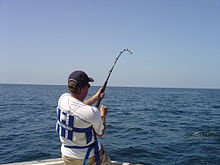
Angling with a fishing rod
A fishing rod is an boosted tool used with the hook, line and sinker. A length of fishing line is attached to a long, flexible rod or pole: one end terminates with the claw for catching the fish. Early line-fishing rods are depicted on inscriptions in ancient Egypt, Cathay, Greece and Rome. In Medieval England they were chosen angles (hence the term line-fishing). As they evolved they were made from materials such as split Tonkin bamboo, Calcutta reed, or ash wood, which were light, tough, and pliable. The butts were frequently made of maple. Handles and grips were fabricated of cork, wood, or wrapped cane. Guides were simple wire loops.
Modern rods are sophisticated casting tools fitted with line guides and a reel for line stowage. They are nearly ordinarily made of fibreglass, carbon fibre or, classically, bamboo. Line-fishing rods vary in activeness besides every bit length, and can be constitute in sizes between 24 inches and xx feet. The longer the rod, the greater the mechanical advantage in casting. At that place are many different types of rods, such as fly rods, tenkara rods, spin and bait casting rods, spinning rods, water ice rods, surf rods, ocean rods and trolling rods.
Line-fishing rods tin exist assorted with line-fishing poles. The line on a angling rod is controlled with a specialised reel which allows accurate casting. A fishing pole does not have a reel. Instead the line is merely tied directly to the tip of the pole, or is tied to some sort of elastic machinery at the tip. Poles tin can be up to 18 m in length and are made of optional sections which can exist slotted together by the angler.
Fishing reels [edit]
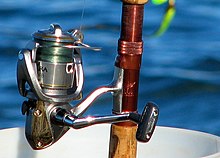
A fishing reel is a device used for the deployment and retrieval of a line-fishing line using a spool mounted on an beam. Fishing reels are traditionally used in angling. They are almost oftentimes used in conjunction with a fishing rod, though some specialized reels are mounted on crossbows or to boat gunwales or transoms. The primeval known illustration of a angling reel is from Chinese paintings and records beginning about 1195 A.D. Angling reels beginning appeared in England around 1650 A.D., and by the 1760s, London tackle shops were advertising multiplying or gear-retrieved reels. Paris, Kentucky, native George Snyder is generally given credit for inventing the first line-fishing reel in America around 1820, a allurement casting design that quickly became popular with American anglers.
Fishing bait [edit]
- Natural baits

Greenish Highlander, an artificial fly used for salmon fishing.
The natural allurement angler ordinarily uses a common casualty species of the fish as an attractant. The natural bait used may be live or dead. Common natural baits include allurement fish, worms, leeches, minnows, frogs, salamanders, nightcrawlers and other insects. Natural baits are effective due to the lifelike texture, scent and colour of the bait presented.
The mutual earthworm is a universal bait for fresh water angling. In the quest for quality worms, some fishers culture their own worm compost or exercise worm mannerly. Grubs and maggots are also considered excellent bait when trout line-fishing. Grasshoppers, flies, bees and even ants are also used every bit bait for trout in their season, although many anglers believe that trout or salmon roe is superior to whatsoever other bait. Studies show that natural baits like croaker and shrimp are more recognized by the fish and are more readily accustomed. A good bait for red drum is menhaden.[5] Because of the risk of transmitting whirling illness, trout and salmon should non be used as bait.
Processed baits, such as groundbait and boilies, can piece of work well with coarse fish, such as carp. For example, in lakes in southern climates such as Florida, fish such as bream will accept staff of life bait. Bread bait is a small amount of breadstuff, oftentimes moistened by saliva, balled up to a pocket-size size that is bite size to minor fish.
- Artificial baits
Many people adopt to fish solely with lures, which are artificial baits designed to entice fish to strike. The artificial bait angler uses a human being-made lure that may or may non represent prey. The lure may require a specialised presentation to impart an enticing action as, for example, in fly fishing. Recently, electronic lures have been developed to attract fish. Anglers have also begun using plastic allurement. A common manner to fish a soft plastic worm is the Texas rig.
Bite indicators [edit]
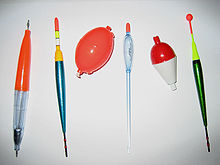
Different types of fishing floats
A bite indicator, also referred to as a strike indicator, is a mechanical or electronic device which indicates to an angler that something is happening at the hook end of the fishing line. There are many types of bite indicators—which work all-time depends on the type of fishing.
Devices in wide utilise as seize with teeth indicators include fishing floats, which float in the h2o and dart about if a fish bites, and quiver tips, which are mounted onto the tip of a fishing rod. Bite alarms are electronic devices which bleep when a fish tugs a fishing line. Floats and quiver tips are visual bite detectors, while bite alarms are audible bite detectors.
In wing fishing a ordinarily used indicator is the "hopper dropper rig". With this technique a nymph or wet fly is hung from the bottom of a floating dry wing. This doubles the chance of a strike from a fish.[six]
Spears [edit]

The Filipino Negritos traditionally used bows and arrows to shoot fish in clear water.[7]
Spearfishing is an ancient method of fishing conducted with an ordinary spear or a specialised variant such as a harpoon, trident, arrow or eel spear. [viii] [9]
Harpoons are spears which have a affront at the finish. Their use was widespread in palaeolithic times.[10] Cosquer cave in Southern French republic contains cave art over 16,000 years old, including drawings of seals which appear to have been harpooned. Tridents are spears which accept three prongs at the business end. They are also called leisters or gigs. They feature widely in early mythology and history.
Mod spears can be used with a speargun. Some spearguns use slings (or rubber loops) to propel the spear. Polespears have a sling attached to the spear, Hawaiian slings have a sling split up from the spear, in the way of an underwater bow and pointer.
A bow or crossbow can be used with arrows in bowfishing.
Nets [edit]

Line-fishing nets are meshes usually formed by knotting a relatively sparse thread. Between 177 and 180 the Greek author Oppian wrote the Halieutica, a didactic poem most angling. He described various means of fishing including the use of nets cast from boats, scoop nets held open past a hoop, and various traps "which work while their masters sleep". Aboriginal line-fishing nets used threads made from leaves, plant stalk and cocoon silk. They could be crude in design and cloth simply some designs were amazingly close to designs we use today (Parker 2002). Modern nets are normally made of bogus polyamides like nylon, although nets of organic polyamides such every bit wool or silk thread were common until recently and are notwithstanding used.
Hand nets are held open up past a hoop, and possibly on the end of a long stiff handle. They have been known since artifact and may be used for sweeping upwards fish near the water surface similar muskellunge and northern motorway. When such a net is used by an angler to help land a fish information technology is known equally a landing net.[11] In the Great britain, hand-netting is the only legal mode of catching glass eels[12] and has been practised for thousands of years on the River Parrett and River Severn.
Cast nets are small round nets with weights on the edges which is thrown by the fisher. Sizes vary upwardly to about 4 metres in bore. The net is thrown by hand in such a way that it spreads out on the water and sinks. Fish are caught equally the internet is hauled back in.[13]
Traps [edit]
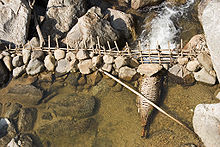
Fishing traps are culturally well-nigh universal and seem to have been independently invented many times. There are essentially ii types of trap, a permanent or semi-permanent structure placed in a river or tidal surface area and pot-traps that are baited to attract prey and periodically lifted. They might have the form of a angling weir or a lobster trap. A typical trap tin can take a frame of thick steel wire in the shape of a eye, with chicken wire stretched around it. The mesh wraps around the frame and so tapers into the inside of the trap. When a fish swims inside through this opening, it cannot get out, equally the chicken wire opening bends back into its original narrowness. In earlier times, traps were constructed of wood and fibre.
Fish stringer [edit]

Simple fish stringer for spearfishing
A fish stringer is a line of rope or chain along which an angler can cord fish that have been caught and then they can exist immersed and kept live in water.[14]
Fly fishing tackle [edit]
Fly fishing tackle is equipment used by, and oft specialised for employ by fly anglers. Wing fishing tackle includes wing lines designed for piece of cake casting, specialised wing reels designed to hold a wing line and supply elevate if required for landing heavy or fast fish, specialised fly rods designed to cast fly lines and artificial flies, terminal tackle including bogus flies, and other accessories including fly boxes used to shop and carry artificial flies.
Tackle boxes [edit]
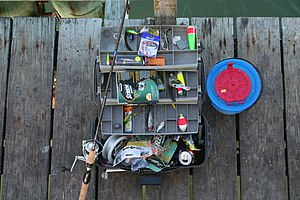
Typical tackle box with rod and allurement bucket
Line-fishing tackle boxes have for many years been an essential part of the anglers equipment. Fishing tackle boxes were originally made of forest or wicker and somewhen some metal line-fishing tackle boxes were manufactured. The first plastic fishing tackle boxes were manufactured past Plano in response to the need for a product that didn't rust. Early on plastic line-fishing tackle boxes were like to tool boxes but soon evolved into the hip roof cantilever tackle boxes with numerous small trays for small tackle. These types of tackle boxes are still available today but they have the disadvantage that small tackle gets mixed upwards. Fishing tackle boxes have also been manufactured so the drawers themselves become small-scale storage boxes, each with their own lids. This prevents small tackle from mixing, and tin plough each drawer into a stand-lonely container which can be used to deport pocket-size tackle to a rod some distance from the master tackle box.
Tackle industry [edit]
Worldwide, the recreational fishing tackle industry is big business, worth over five billion U.s. dollars annually in the United states alone.[fifteen] Notable brands include The Shakespeare Visitor, Orvis, Lindy Legendary Fishing Tackle and Simms Fishing Products.
Notes [edit]
- ^ "Online Etymology Dictionary". Retrieved 23 April 2017.
- ^ Ewalt, David M. (five Baronial 2005). "No. 19: The Fish Hook". Archived from the original on June 30, 2012. Retrieved 23 April 2017.
- ^ Henshall, James (Dr.), Volume of the Black Bass (1881)
- ^ MPCA Home > Sustainability > Reduce Reuse Recycle > Nontoxic Tackle: Let's go the lead out! Archived Apr twenty, 2010, at the Wayback Auto
- ^ Gunnar Miesen; Steve Hague; Steve Hauge (2004). Alive Bait Fishing: Including Doughbait & Odour . Creative Publishing. ISBN1-58923-146-5.
- ^ "Fly fishing The Hopper Dropper Rig and Chernobyl Ants with Nymphs". 17 July 2013. Retrieved 23 April 2017.
- ^ March, Alden (1899) The history and conquest of the Philippines and our other island possessions; embracing our war with the Filipinos in 1899 Page 39.
- ^ Image of an eel spear.
- ^ Spear fishing for eels Archived 2009-08-13 at the Wayback Machine.
- ^ Guthrie, Dale Guthrie (2005) The Nature of Paleolithic Art. Folio 298. Academy of Chicago Press. ISBN 0-226-31126-0
- ^ "Angling Tools - Landing Nets". Archived from the original on fifteen September 2008. Retrieved 23 April 2017.
- ^ "Eel Regulations: Eel line-fishing". eelregulations.co.uk . Retrieved 2018-04-17 .
- ^ Casting net.
- ^ Toth, Mike (2000) The Complete Idiot's Guide to Fishing Basics 2d edition, pp. 158–159, Penguin. ISBN 9781101222126.
- ^ 2006 National Survey of Fishing, Hunting, and Wild animals-Associated Recreation U.S. Fish & Wildlife Service, page 9.
References [edit]
- Burdon (1951) A Consideration of the Classification of Fishing Gear Asia-Pacific Fishery Commission, Technical paper.
- FAO: Fishing gears and methods
- FAO: Search Technology Fact Sheets: Fishing Gear type
- Fridman AL and Carrothers PJG (1986) Calculations for fishing gear designs (FAO fishing transmission), Fishing News Books. ISBN 978-0-85238-141-0
- Klust, Gerhard (1982) Netting materials for fishing gear FAO Angling Manuals, Fishing News Books. ISBN 978-0-85238-118-2. Download PHP (9MB)
- Misund, Ole Arve; Kolding, Jeppe and Freon, Pierre (2002) Handbook of Fish Biology and Fisheries, Affiliate 2, Fish capture devices in industrial and artisanal fisheries. Blackwell Publishing. ISBN 0-632-06482-X
- Larson, Todd (2007) History of the Fish Claw in America Vol. 1, The Whitefish Press.
- Pfeiffer, C. Boyd (1999)The Field & Stream Tackle Care and Repair Handbook. Globe Pequot. ISBN 978-1-55821-898-7.
- von Brandt A (1984) Fish communicable methods of the world Wiley-Blackwell. ISBN 978-0-85238-280-6.
DOWNLOAD HERE
Blue Plastic Ring With 2 Wires With Loops at the End Fishing Gear UPDATED
Posted by: geraldthasuppeas.blogspot.com